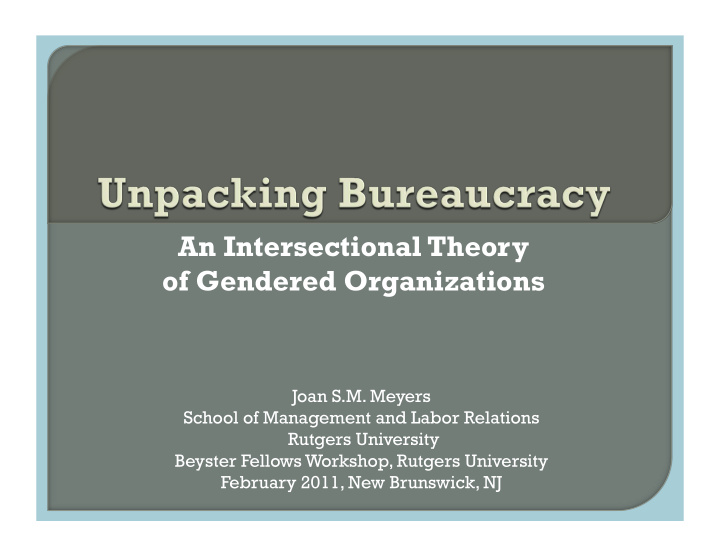



An Intersectional Theory of Gendered Organizations Joan S.M. Meyers School of Management and Labor Relations Rutgers University Beyster Fellows Workshop, Rutgers University February 2011, New Brunswick, NJ
Unpacking bureaucracy • Horizontal vs. vertical power • Formal rules, practices, policies Unpacking gender • Intersectional analysis (Collins 1990) 2
Two worker-owned cooperatives • One World Natural Grocery (215 employees) • People’s Daily Bread Bakery (112 employees) The issues • Class and organizational type • Bureaucratic features and gender (and race and class) 3
How do organizational power & the degree of formality interact to influence gender inequality? • Job access • Wealth • Power within organization • Job autonomy What can democratic employee ownership tell us about this? 4
Qualitative comparative research spanning 3 years • Phase 1: 12 interviews, 4 meetings • Phase 2: Ten weeks of intensive observation; a year of meeting & orientation attendance; two years attending informal gatherings at each site • Phase 3: archival research & financial records HyperRESEARCH to code & analyze Inductive & deductive 5
BAKERY: GROCERY: MANAGERIAL HIERARCHY HYBRID DEMOCRACY Board of directors elected from employees Highly formal : policy & orientation manuals; financial reports; disciplinary records; team logs; team, committee, & company meeting agendas; meeting minutes; orientations; safety trainings; etc. 6
+ > county average household earnings + 3:1 maximum pay differential + 40% people of color in 7% county + majority working-class managers + women’s earnings 112% that of men + 31% women managers - women only 15% of workforce - 87% of women employees white - 50% of women in all-women office team - 83% of people of color in all-men production teams - people of color’s earnings 80% that of whites - most autonomous jobs held by whites; people of color in least autonomous jobs 7
- < county average household earnings - whites overrepresented for county - whites, middle-class overrepresented on board - women’s earnings 87% that of men + > hourly earnings than county average + > women’s hourly earnings (across race) + women 56% of workforce (non-white 25%) + people of color’s earnings 102% that of whites + no discernable race/gender patterns to teams + no race/gender/class difference in team/job autonomy 8
Bakery Grocery Hierarchy reduces openness to alternative job histories, Hybrid democracy maximizes inclusion, Access formality reproduces formality protects against homosociality occupational segregation Hierarchy naturalizes workplace Hybrid democracy democratic control inequalities, formality obscures interrupts cultural capital link to wealth, Wealth and cements ethnoracial formal equalities of wealth-sharing inequality protect those without elite advantage Hierarchy attributes superior Formal codification of hybrid democratic skills to managers, formal practices distributes power across Power empowerment of workers ethnoracial, class, and gender undermined by hierarchy differences Formal allocation of job control Formal delegation of authority combined to supervisors reduces autonomy with heterosociality of teams to Autonomy for women & most people of distribute autonomy of jobs and teams color, but could be subverted by across gender, race, and class majority white male teams 9
Hierarchy reduces openness to alternative job histories, formality reproduces occupational segregation • Turn-over in worst jobs • Manager reliance on ethnoracially segregated external labor market for recruitment & retention strategies • Managers’ internalized gender beliefs • Individualized hiring decisions • Inflexible, manager-created formal schedules • Result: no Latina access to best bakery entry point; reduced gender balance 10
Hybrid democracy maximizes inclusion, formality protects against homosociality • No single “entry point,” cross-team work urged • Previous industry, not job, experience valued • Flat but livable first-year wages • Hiring by committee using formal, team-created hiring policy • Individual/team-created flexible formal schedules • Result: ethnoracially diverse gender balance • Counter example: lack of formality and buyers 11
“Bureaucracy” requires unpacking: harmful and protective configurations Race and class inequality mechanisms have gender effects Interconnections between organizational form and inequality mechanisms help explain workplace gender inequality outcomes 12
Questions or feedback to jmeyers@work.rutgers.edu 13
Recommend
More recommend